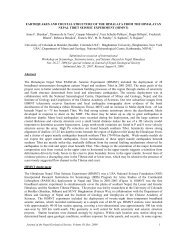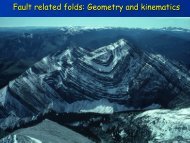The Mohr Stress Diagram
The Mohr Stress Diagram
The Mohr Stress Diagram
Create successful ePaper yourself
Turn your PDF publications into a flip-book with our unique Google optimized e-Paper software.
<strong>The</strong> <strong>Mohr</strong> <strong>Stress</strong> <strong>Diagram</strong><br />
Edvard Munch as a young geologist!
<strong>The</strong> <strong>Mohr</strong> <strong>Stress</strong> <strong>Diagram</strong><br />
A means by which two stresses acting on a plane of known<br />
orientation can be plotted as the components of normal and<br />
shear stresses (derived separately from each of the two stresses).<br />
<strong>The</strong> <strong>Mohr</strong> circle is thus an elegant way to determine the shear and<br />
normal stresses for a pair of stresses oriented obliquely to the plane<br />
in question. <strong>The</strong> <strong>Mohr</strong> circle allows you to quickly read this for<br />
planes of any orientation.<br />
It also makes it easy to visualize mean stress and differences in<br />
stress, or deviatoric stress and relate these to deformation.
Setting up the Problem (we did this previously for one stress)
Add another stress & calculate their normal and shear components<br />
<strong>The</strong> angle theta is the angle between the maximum !<br />
principle stress and the plane it is acting on…
Decompose two original stresses into their x and y components!<br />
After several trigonometric and algebraic manipulations,<br />
the two equations left are ……
<strong>Stress</strong> Equations<br />
Two perpendicular stresses oriented at any<br />
angle to a plane!<br />
Normal <strong>Stress</strong><br />
σ n = (σ 1 + σ 3 ) - (σ 1 - σ 3 ) cos 2Θ!<br />
2!<br />
2!<br />
Shear <strong>Stress</strong><br />
σ s = (σ 1 - σ 3 ) sin 2Θ!<br />
2!
<strong>The</strong> <strong>Mohr</strong> <strong>Stress</strong> <strong>Diagram</strong><br />
σ n = (σ 1 + σ 3 ) - (σ 1 - σ 3 ) cos 2Θ!<br />
2!<br />
2!<br />
<strong>The</strong>ta = angle between !<br />
the maximum stress and<br />
the plane it is acting on.!<br />
σ s = (σ 1 - σ 3 ) sin 2Θ!<br />
2!
<strong>The</strong> <strong>Mohr</strong> Circle - (mean or average stress)<br />
Mean <strong>Stress</strong>!
<strong>The</strong> <strong>Mohr</strong> Circle – radius or deviatoric stress<br />
Deviatoric <strong>Stress</strong>!
<strong>The</strong> <strong>Mohr</strong> Circle – diameter or differential stress<br />
Differential <strong>Stress</strong>!
Laboratory Experiments in Rock Deformation<br />
Deformed marble rock cylinders
Laboratory Experiments in Rock Deformation<br />
<strong>Stress</strong> a rock sample until it fractures (or flows)
In-class exercise, work in groups of 4, turn in write up of answers.<br />
Given these samples, discuss how the magnitude of stresses likely<br />
varied relative to one another in these four experiments. Each<br />
cylinder was deformed in a different experiment, each with its<br />
own axial and radial load (which varied relative to one another).
In-class problem!<br />
1. For maximum and minimum stresses of 600 and 200<br />
mega-pascals (MPa) oriented as a vertical vector and a<br />
horizontal, E-W striking vector (respectively), determine<br />
the normal and shear stresses on a plane oriented North-<br />
South, 45 degrees East. It helps to first draw a block<br />
diagram.<br />
2. So max stress is oriented vertically and equal to 600 MPA<br />
3. Min stress is horizontal, oriented east-west and = 200 MPa
In-class problem!<br />
<strong>The</strong>re are two ways to solve these problems.<br />
Use the <strong>Mohr</strong> <strong>Stress</strong> <strong>Diagram</strong> or<br />
Use the equations<br />
(extra credit if you do both…)
Determine the normal and shear stresses on a plane oriented N-S, 45 o E<br />
Maximum stress is oriented vertically and equal to 600 MPA<br />
Minimum stress is horizontal, oriented east-west and = 200 MPa<br />
Use the <strong>Mohr</strong> <strong>Stress</strong> <strong>Diagram</strong>!
For maximum and minimum stresses of 600 and 200 (MPa) oriented as<br />
a vertical vector and a horizontal, E-W striking vector (respectively),<br />
determine the normal and shear stresses on a plane oriented North-<br />
South, 45 degrees East. It helps to first draw a block diagram.<br />
Use the Equations!<br />
σ n = (σ 1 + σ 3 ) - (σ 1 - σ 3 ) cos 2Θ!<br />
2!<br />
2!<br />
σ s = (σ 1 - σ 3 ) sin 2Θ!<br />
2!<br />
For the minimum and maximum principle stresses of 600 and 200<br />
megapascals (MPa) oriented as a vertical vector and a horizontal,<br />
E-W striking vector (respectively), determine the normal and shear<br />
stresses on a plane oriented North-South, 45 degrees East
2 For the stress state in the previous problem, determine the differential<br />
stress and mean stress. Start by plotting the solution for normal and<br />
shear stresses on the <strong>Mohr</strong> <strong>Stress</strong> <strong>Diagram</strong>.<br />
Problem 2!<br />
3 Determine whether decreasing the dip of the fault will decrease or<br />
increase the shear stress acting on it.<br />
4 Discuss how a change in differential stress might affect whether a<br />
rock might be more or less likely to break. It may help by arbitrarily<br />
varying the stresses and looking at how they plot on the circle, or by<br />
imagining stress on a cube.<br />
5 Now discuss whether increasing the mean stress would cause a rock<br />
to break more readily. Would this be more or less likely with<br />
increasing depth in the crust<br />
6 Draw the stress state where the minimum and maximum stresses are<br />
both equal to 600 Mpa.
Following set of slides should be copied and handed out to students for<br />
exercises. Work in groups of 4, so for a class of 80 students, print out 20<br />
sets.
In-class exercise, work in groups of 4 & turn in a write up of your answers.<br />
Problem 1.1 Given these samples, discuss how the magnitude and<br />
mean stresses likely varied relative to one another in these four samples.<br />
Each cylinder was deformed in a different experiment, each with its<br />
own axial and radial load (which varied relative to one another).
In-class problem 1.2<br />
For maximum and minimum stresses of 600 and 200 megapascals<br />
(MPa) oriented as a vertical vector and a horizontal, E-<br />
W striking vector (respectively), determine the normal and shear<br />
stresses on a plane oriented North-South, 45 degrees East. It<br />
helps to first draw a block diagram.<br />
So max stress is oriented vertically and equal to 600 MPA<br />
Min stress is horizontal, oriented east-west and = 200 MPa
For maximum and minimum stresses of 600 and 200 megapascals<br />
(MPa) oriented as a vertical vector and a horizontal, E-W striking<br />
vector (respectively), determine the normal and shear stresses on a<br />
plane oriented North-South, 45 degrees East. It helps to first draw a<br />
block diagram.<br />
Use the Equations!<br />
σ n = (σ 1 + σ 3 ) - (σ 1 - σ 3 ) cos 2Θ!<br />
2!<br />
2!<br />
σ s = (σ 1 - σ 3 ) sin 2Θ!<br />
2!
Or use the <strong>Mohr</strong> Circle!
For the stress state in the previous problem, determine the differential<br />
stress and mean stress. Start by plotting the solution for normal and shear<br />
stresses on the <strong>Mohr</strong> <strong>Stress</strong> <strong>Diagram</strong>.<br />
Determine whether decreasing the dip of the fault will decrease or<br />
increase the shear stress acting on it.<br />
Discuss how a change in differential stress might make the sample more<br />
or less likely to break. It may help by arbitrarily varying the stresses and<br />
looking at how they plot on the circle, or by imagining stress on a cube.<br />
Now discuss whether increasing just the mean stress would cause a rock<br />
to break more readily. Would this be more or less likely with increasing<br />
depth in the crust<br />
Draw the stress state where the minimum and maximum stresses are both<br />
equal to 600 MPa. What is the differential stress. Would you expect the<br />
rock to deform under these conditions
In-class problem 2.2<br />
1. For the stress state in the previous problem, determine the<br />
differential stress and mean stress. Start by plotting the<br />
solution for normal and shear stresses on the <strong>Mohr</strong> <strong>Stress</strong><br />
<strong>Diagram</strong>.
In-class problem 2.3<br />
1. Determine whether decreasing the dip of the fault will<br />
decrease or increase the shear stress acting on it.
In-class problem 2.4<br />
Discuss how a change in differential stress might make the<br />
sample more or less likely to break. It may help by<br />
arbitrarily varying the stresses and looking at how they<br />
plot on the circle, or by imagining stress on a cube.
In-class problem 2.5<br />
1. Now discuss whether increasing the mean stress would cause<br />
a rock to break more readily. Would this be more or less likely<br />
with increasing depth in the crust
In-class problem 2.6<br />
1. Draw the stress state where the minimum and maximum<br />
stresses are both equal to 600 Mpa. What is the differential<br />
stress Would you expect the rock to deform under these<br />
conditions
In-class problem 2<br />
For the stress state in the previous problem, determine the differential stress<br />
and mean stress. Start by plotting the solution for normal and shear stresses<br />
on the <strong>Mohr</strong> <strong>Stress</strong> <strong>Diagram</strong>.<br />
Determine whether decreasing the dip of the fault will decrease or increase<br />
the shear stress acting on it.<br />
Discuss how a change in differential stress might make the sample more or<br />
less likely to break. It may help by arbitrarily varying the stresses and looking<br />
at how they plot on the circle, or by imagining stress on a cube.<br />
Now discuss whether increasing just the mean stress would cause a rock to<br />
break more readily. Would this be more or less likely with increasing depth in<br />
the crust<br />
Draw the stress state where the minimum and maximum stresses are both<br />
equal to 600 Mpa. What is the differential stress. Would you expect the rock<br />
to deform under these conditions









